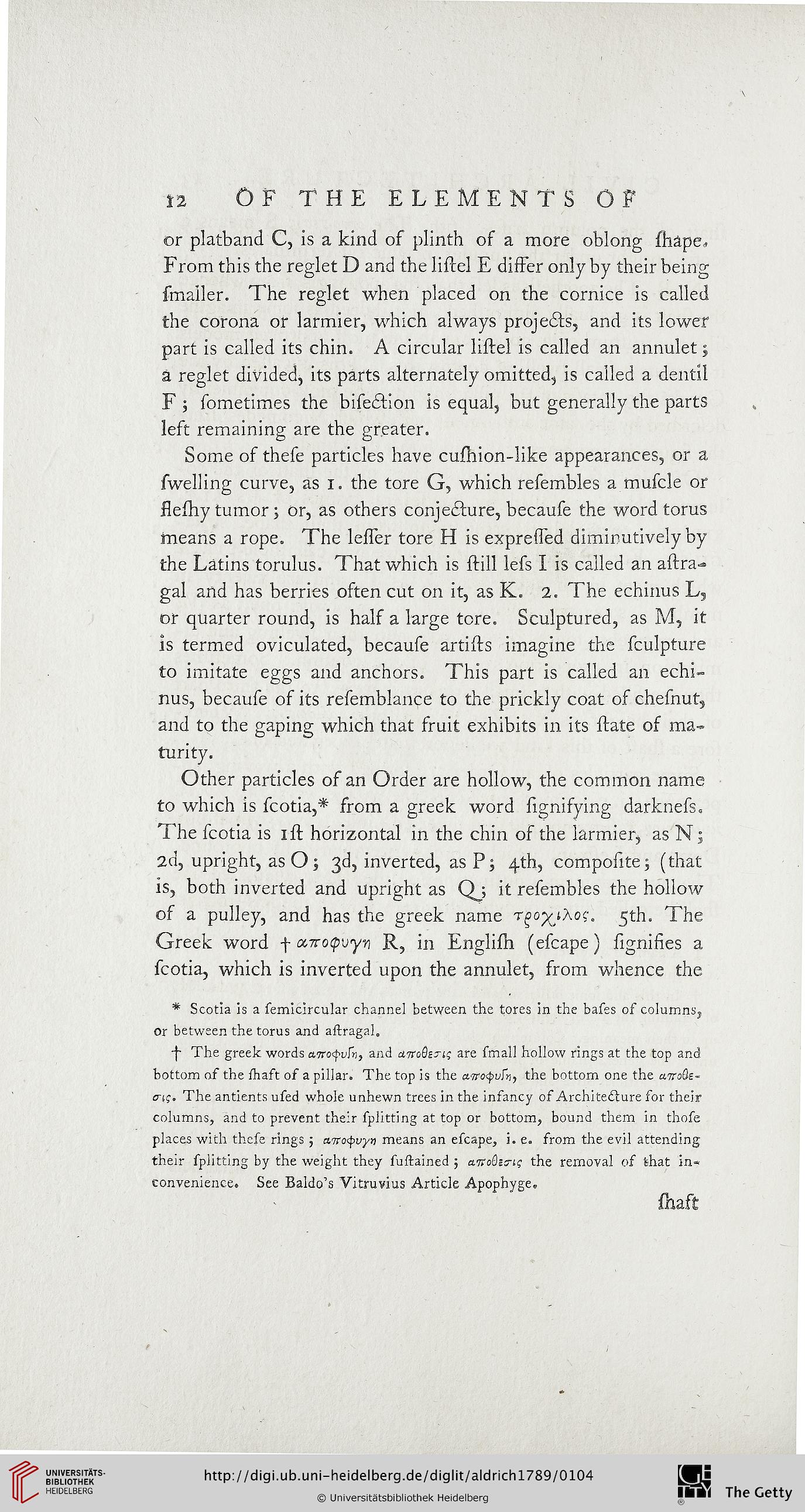12
OF THE ELEMENTS OF
or platband C, is a kind of plinth of a more oblong shape*
From this the reglet D and the listel E differ only by their being
smailer. The reglet when placed on the cornice is called
the corona or larmier, which always projects, and its lower
part is called its chin. A circular listel is called an annulet $
a reglet divided, its parts alternately omitted, is called a dentil
F ; sometimes the bisedtion is equal, but generally the parts
left remaining are the greater.
Some of these particles have cushion-like appearances, or a
swelling curve, as 1. the tore G, which resembles a muscle or
sseshy tumor; or, as others conjecture, because the word torus
means a rope. The lesser tore H is expressed diminutively by
the Latins torulus. That which is still less I is called an astra-*
gal and has berries often cut on it, as K. 2. The echinus L,
or quarter round, is half a large tore. Sculptured, as M, it
is termed oviculated, because artists imagine the sculpture
to imitate eggs and anchors. This part is called an echi-
nus, because of its resemblance to the prickly coat of chesnut,
and to the gaping which that fruit exhibits in its state of ma-
turity.
Other particles of an Order are hollow, the common name
to which is scotia,* srom a greek word Signifying darkness.
The scotia is 1 st horizontal in the chin of the larmier, as N;
2d, upright, as O; 3d, inverted, asP; 4th, composite; (that
is, both inverted and upright as Qj it resembles the hollow
of a pulley, and has the greek name rgoyjAoc. 5th. The
Greek word f cnrotpvyn R, in English (escape) Signifies a
scotia, which is inverted upon the annulet, from whence the
* Scotia is a semicircular channel between the tores in the bates of columns,
or between the torus and astragal.
-}- The greek words am<pvsn, and uitoObji; are small hollow rings at the top and
bottom of the shaft os a pillar. The top is the airotyufa, the bottom one the ctTroOs-
a <?. The antients used whole unhewn trees in the infancy of Architecture sor their
columns, and to prevent their splitting at top or bottom, bound them in those
places with these rings ; aircupvyn means an escape, i. e. from the evil attending
their splitting by the weight they sustained ; avroQ-s-tg the removal of that in-
convenience. See Baldo’s Vitruvius Article Apophyge.
Shaft
OF THE ELEMENTS OF
or platband C, is a kind of plinth of a more oblong shape*
From this the reglet D and the listel E differ only by their being
smailer. The reglet when placed on the cornice is called
the corona or larmier, which always projects, and its lower
part is called its chin. A circular listel is called an annulet $
a reglet divided, its parts alternately omitted, is called a dentil
F ; sometimes the bisedtion is equal, but generally the parts
left remaining are the greater.
Some of these particles have cushion-like appearances, or a
swelling curve, as 1. the tore G, which resembles a muscle or
sseshy tumor; or, as others conjecture, because the word torus
means a rope. The lesser tore H is expressed diminutively by
the Latins torulus. That which is still less I is called an astra-*
gal and has berries often cut on it, as K. 2. The echinus L,
or quarter round, is half a large tore. Sculptured, as M, it
is termed oviculated, because artists imagine the sculpture
to imitate eggs and anchors. This part is called an echi-
nus, because of its resemblance to the prickly coat of chesnut,
and to the gaping which that fruit exhibits in its state of ma-
turity.
Other particles of an Order are hollow, the common name
to which is scotia,* srom a greek word Signifying darkness.
The scotia is 1 st horizontal in the chin of the larmier, as N;
2d, upright, as O; 3d, inverted, asP; 4th, composite; (that
is, both inverted and upright as Qj it resembles the hollow
of a pulley, and has the greek name rgoyjAoc. 5th. The
Greek word f cnrotpvyn R, in English (escape) Signifies a
scotia, which is inverted upon the annulet, from whence the
* Scotia is a semicircular channel between the tores in the bates of columns,
or between the torus and astragal.
-}- The greek words am<pvsn, and uitoObji; are small hollow rings at the top and
bottom of the shaft os a pillar. The top is the airotyufa, the bottom one the ctTroOs-
a <?. The antients used whole unhewn trees in the infancy of Architecture sor their
columns, and to prevent their splitting at top or bottom, bound them in those
places with these rings ; aircupvyn means an escape, i. e. from the evil attending
their splitting by the weight they sustained ; avroQ-s-tg the removal of that in-
convenience. See Baldo’s Vitruvius Article Apophyge.
Shaft





